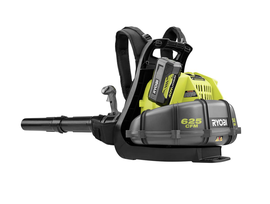Toro Ultra 51619 Review
Available from Home Depot and Walmart
 Cheapism dug through thousands of consumer and expert reviews to unearth leaf blowers under $150 with an elusive combination of value, performance, ease of use, and durability. Among our picks are gas and electric leaf blowers, including cordless battery-powered models. For consumers who prefer a backpack leaf blower, which raises the price, we found a relatively cheap one that increases mobility and can save users from sore arms in the long run. In our full buying guide, we explain what features to look for when choosing the best cheap leaf blower, as well as the benefits — and potential drawbacks — of each type.
Cheapism dug through thousands of consumer and expert reviews to unearth leaf blowers under $150 with an elusive combination of value, performance, ease of use, and durability. Among our picks are gas and electric leaf blowers, including cordless battery-powered models. For consumers who prefer a backpack leaf blower, which raises the price, we found a relatively cheap one that increases mobility and can save users from sore arms in the long run. In our full buying guide, we explain what features to look for when choosing the best cheap leaf blower, as well as the benefits — and potential drawbacks — of each type.
Prices and availability are subject to change.

Available from Home Depot and Walmart

Available from Home Depot and Walmart
Pros:
Cons:
 Takeaway: At less than $100, the Toro Ultra blower vac is an affordable, versatile option for anyone who doesn't mind dealing with an extension cord. Consumers are enthusiastic for the most part, and there is no shortage of positive comments posted on retailers' websites. Earning an average of 4.4 stars from almost 6,000 reviews at Home Depot, the Toro Ultra is described as an easy-to-use blower that also performs reasonably well as a mulcher and lawn vacuum (although there are some complaints of clogging with the latter function). Homeowners looking for a little extra power and finer mulching capabilities might consider the nearly identical Toro 51621, which does an even better job in expert testing and sells for about $10 more.
Takeaway: At less than $100, the Toro Ultra blower vac is an affordable, versatile option for anyone who doesn't mind dealing with an extension cord. Consumers are enthusiastic for the most part, and there is no shortage of positive comments posted on retailers' websites. Earning an average of 4.4 stars from almost 6,000 reviews at Home Depot, the Toro Ultra is described as an easy-to-use blower that also performs reasonably well as a mulcher and lawn vacuum (although there are some complaints of clogging with the latter function). Homeowners looking for a little extra power and finer mulching capabilities might consider the nearly identical Toro 51621, which does an even better job in expert testing and sells for about $10 more.

Pros:
Cons:
Takeaway: Despite its extremely low price, the Black & Decker LB700 is an effective piece of outdoor power equipment, at least according to the very positive average rating it receives from more than 12,000 Amazon customer reviews. This corded electric leaf blower isn't really designed for big yards, but for small household tasks — clearing the driveway of grass clippings, whisking dead leaves from a patio, even blow-drying a freshly washed car — it does just fine, a majority of buyers say. We read a number of positive reviews from older people, saying the LB700 is a cinch to use because of its light weight. Like similarly cheap leaf blowers, this model lacks vacuum and mulching capability and doesn't come with extra nozzles or attachments. There's also no cord included, which means that buyers could end up spending as much for an extra-long, heavy-duty, three-prong extension cord as for the machine itself.

Pros:
Cons:
Takeaway: The Black & Decker BV6600 is equally capable in an open yard or fussy flower beds, and scores of fans say it produces nicely shredded mulch. This corded electric model also has variable speeds and a durable metal impeller, features that users appreciate. One slight drawback: There are no nozzles included for gutters or other tight spots, a potential deal-breaker for people with lots of landscaping. On the plus side, given numerous complaints about the quality of the leaf bags on this and other blower vacs, Black & Decker has disposable leaf bags available that can be used instead. Considering the relatively high cost of standard replacement bags, this option could yield serious savings in the long run.

Available from Home Depot and Walmart
Pros:
Cons:
 Takeaway: Battery-powered leaf blowers in this price range don't often do double-duty as a lawn vac and mulcher, but this Black & Decker cordless leaf blower does it all. It earns top billing at Top Ten Reviews, where editors say that its overall performance, versatility, and ease of use make it a standout. With enough power to handle most yard tasks — despite its relatively low 120 mph airflow — it was also one of the lightest and quietest models they tested. Most users report about 30 minutes of run time on a fully charged battery, which is on par with other cordless leaf blowers, and recharge time is less than an hour. Just note that some owners say the vacuum bag's zipper is prone to breaking.
Takeaway: Battery-powered leaf blowers in this price range don't often do double-duty as a lawn vac and mulcher, but this Black & Decker cordless leaf blower does it all. It earns top billing at Top Ten Reviews, where editors say that its overall performance, versatility, and ease of use make it a standout. With enough power to handle most yard tasks — despite its relatively low 120 mph airflow — it was also one of the lightest and quietest models they tested. Most users report about 30 minutes of run time on a fully charged battery, which is on par with other cordless leaf blowers, and recharge time is less than an hour. Just note that some owners say the vacuum bag's zipper is prone to breaking.

Available from Home Depot
Pros:
Cons:
Takeaway: Most professional reviewers overlook this cheap battery-powered electric leaf blower, but it's a very popular cordless model at Home Depot, where more than 3,600 consumers have contributed reviews. This Ryobi cordless blower isn't quite as powerful at other models in this report, but its variable-speed motor can generate 100 mph and 280 CFM of air power, which is definitely sufficient for patios, driveways, and light yard debris, users say. Anything more demanding, however, and you're likely to be disappointed. It weighs 9 pounds, making it heftier than other cordless leaf blowers, yet few reviewers complain about the weight. One thing some owners do gripe about is the lack of a nozzle or similar attachment for clearing debris in tight spaces.

Pros:
Cons:
 Takeaway: If you’re looking for a cheap gas-powered blower, you won’t find many that are as powerful as this Craftsman for the price. The two-stroke engine produces 200 mph of blowing power (430 CFM air volume), and buyers say it makes short work of dislodging wet, matted debris, and sweeping away dead leaves. It’s rated at 72 decibels (about on par with a vacuum cleaner), which isn’t as loud as some other gas-powered models, but it's not as quiet as the battery-powered blowers in our roundup, either. On Amazon, it earns a 4.3 rating from nearly 3,000 shoppers. As with other gas blowers, some reviewers complain that the Craftsman can be hard to start. Other owners note that the leaf blower, which weighs 10 pounds, can be cumbersome to hold for long periods of time. In general, however, this gas-powered leaf blower packs a punch for one so inexpensive.
Takeaway: If you’re looking for a cheap gas-powered blower, you won’t find many that are as powerful as this Craftsman for the price. The two-stroke engine produces 200 mph of blowing power (430 CFM air volume), and buyers say it makes short work of dislodging wet, matted debris, and sweeping away dead leaves. It’s rated at 72 decibels (about on par with a vacuum cleaner), which isn’t as loud as some other gas-powered models, but it's not as quiet as the battery-powered blowers in our roundup, either. On Amazon, it earns a 4.3 rating from nearly 3,000 shoppers. As with other gas blowers, some reviewers complain that the Craftsman can be hard to start. Other owners note that the leaf blower, which weighs 10 pounds, can be cumbersome to hold for long periods of time. In general, however, this gas-powered leaf blower packs a punch for one so inexpensive.

Pros:
Cons:
Takeaway: When an electric leaf blower simply can't get the job done, the Husqvarna 125B is a good pick for clearing significant yard debris without spending a slew of cash. This entry-level Husqvarna gas leaf blower can produce an air speed of 170 mph (425 CFM air volume) and, even better, it's designed to do an effective job while keeping user comfort a priority — not true of all cheap blowers. The most common complaint comes from buyers who say their leaf blower's engine either began running rough or stopped working entirely after the first season's use. A likely cause, say professional testers, is using fuel that's blended with ethanol or not using fresh gas before running it after a period of disuse. While its slightly higher price tag keeps it out of our top spot for best handheld gas leaf blower, all in all it's a decent choice, at an affordable price, from a trusted brand.

Available from Home Depot
Pros:
Cons:
Takeaway: Backpack leaf blowers like this one are designed for homeowners with larger yards, trees, and landscaping to maintain. The battery-powered Ryobi RY40440 comes in under the $300 mark; gas-powered models can sell for twice the price. This backpack blower doesn't get the same wildly enthusiastic reviews that pricier, more powerful models do — such as the gas-powered Husqvarna 350BT ($330 from Amazon) — but with an air speed of 145 mph and 625 CFM airflow in the pipe, most owners say it'll get the job done. The backpack is comfortable to wear for most users, according to online feedback, and it's much quieter than gas-powered backpack leaf blowers: Rated at 59 decibels, it is about as loud as a normal conversation.